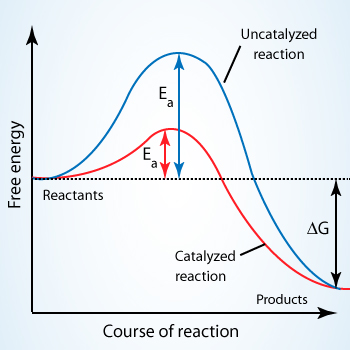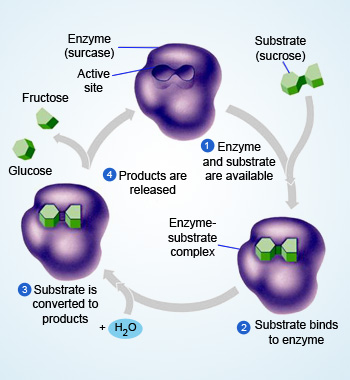 Enzyme lowers the activation energy of a reaction. Thus large number of substrate molecules can
participate in the reaction and consequently, rate of reaction increases.
Enzyme lowers the activation energy of a reaction. Thus large number of substrate molecules can
participate in the reaction and consequently, rate of reaction increases.
Enzymes are the bio catalysts that catalyzes the chemical reactions taking place inside the living organisms.
Without enzymes, these reactions would be too slow to sustain life. Enzymes speed up rate of reactions ten million times than
compared to uncatalyzed reactions.
Enzymes–substrate reactions are highly specific. A typical cell, on an average, contains about 3000 different kinds of enzymes, each catalyzing a different reaction. Substrate binds at the active site of an enzyme (a site where catalysis occur). Chemical reaction takes place and enzyme is recovered at the end of the reaction. Thus only a small amount of enzyme is sufficient to catalyze the large amount of substrate.
Chemically, enzymes are proteins. Some enzymes are associated with cofactors (non–protein components), essential for their activity. Such enzymes are called holoenzymes. The protein component of this enzyme is called apoenzyme whereas the non–protein component is called prosthetic group. The cofactor may be a metal ion as, for e.g., zinc atom of carbonic anhydrase that catalyzes the inter conversion of carbon dioxide and water to bicarbonate and protons. Others may require the presence of an organic molecule and hence are called co–enzymes, eg., NAD+.
 Enzyme–substrate Reaction
Hydrolysis of sucrose in the presence of sucrase produces one molecule of glucose and one molecule of
fructose.
Enzyme–substrate Reaction
Hydrolysis of sucrose in the presence of sucrase produces one molecule of glucose and one molecule of
fructose.
Enzymes can be classified into following major types:
- Oxidoreductases: Catalyze oxidation and reduction processes, e.g., dehydrogenases and oxidases.
- Transferases: Catalyze the transfer of a specific group from one substrate to another, e.g., transaminases, kinases.
- Lyases: Catalyze the nonhydrolytic cleavage of various chemical bond, e.g., aldolases.
- Hydrolases: Participate in hydrolysis of substrates, e.g., esterases.
- Ligases: Catalyze synthetic reactions, e.g., citric acid synthetase.
- Isomerases: Catalyze the reactions that involve the change of the molecular form of a substrate, e.g., triose phosphate isomerase.
The molecule that inhibits or decreases the activity of an enzyme is called an inhibitor. Many drugs and poisons are enzyme inhibitors. Aspirin is a non–steroidal anti–inflammatory drug which inhibits the COX 1 and COX 2 enzymes that catalyzes the production of inflammatory agents 'prostaglandins'. On the contrary, cyanide is an irreversible inhibitor that combines with the active site of the cytochrome c oxidase and blocks cellular respiration.
As enzymes accelerate the rate of several reactions they are widely used in the manufacture of beer, wine, syrups, and in the production of cheese. They also play vital role in the genetic engineering techniques.
Albinism is a hereditary disease that is caused by the deficiency of an enzyme, tyrosinase, that catalyzes the production of melanin (primary determinant of the skin color in humans) and other pigments. Albinism is characterized by the partial or complete absence of pigments in the skin.